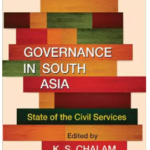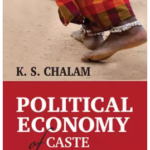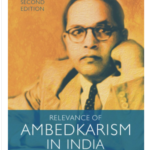Prof K S Chalam, well known contemporary thinker and academic has published a very thought provoking and relevant book for our times. He is one of our comrades who has been writing in the traditions of Lohia, Roy, Marx, Ambedkar for the last several decades, though he hails from the mainstream academic profession as a Professor of Economics,. He has been Vice-chancellor and held some important positions in Delhi. I am informing our readers about the book as we do not expect that the mainstream media to shed light on such writings as it brings out the need for unity among democratic and socialist forces to take on the evangelists.
Sismondi and Surplus Value
The book makes an attempt to bring to life Sismondi the Pre-Marxian scholar and original contributor of the concept of surplus value as a part of ‘Social Economy’ as study of the dynamics of socioeconomic parameters in a traditionally fragmented society like India. He analyses that how the theory is re-emerging in the context of globalisation. He has clarified that it is not directly related to the study of civil society or third sector activities of advanced countries as expressed by some perverse scholars. It is much wider in its scope and content and is a unique approach to study a country like India. In fact, the third sector has never been autonomous and alleged to have been used to side-track the radical upsurge against the ugly designs of corporate capitalism. Like the selling costs of a firm that drive customers towards its brand, civil society activities are suspected to be used by market players with a hidden economic agenda. (Our experience with different kinds of revolutions sponsored by some of the civil societies in Middle East and the result).It is necessary to dispel the vilification of Social Economics by neo-classical writers.
The Social economy expounded by pre-Marxian scholar Sismondi, developed by Tawny, Hobson and Schumacher and others is now being pursued to understand the tyranny of Neo-colonialism and its consequences. The echo of some of the issues pursued by the subject are found in Welfare Economics .Social Economics was concerned about the abuse of labour, of competition, on the excess of production etc as it declared a disbelief in laissez-faire. The ideas of the social economists are found their way in the discussions of scholars who are humanistic in their approach to development as against those whose ideas are responsible for devastation, degradation of ecology and human values.
Mainstream Economics has helped to solve problems of poverty, inequality, want and disease under certain assumptions of a class society. Indian economists including B R Ambedkar, Rammanoha Lohia, Amartya Sen and a few others have used the concepts and found that the caste based economy and society need something more than what is given in the text books. They have partially succeeded to address the typical problems of caste. Some ideologues recognized the problem and equated it with class. However, it has not enhanced our understanding of the social economy of castes and even untouchability and discrimination. Market has not provided answers to this problem and alleged to have been a conduit to strengthen the already existing social inequalities in India. In this context, interrogating the liberal economic policies and their consequences in the area of social tensions, political process, inequalities in Human development, marginalization of agriculture, language and culture and so on in a caste-based society like India is attempted in the book with an alternative paradigm of development based on Indian thinking in the subject. The subject matter of Social Economy as a branch of Economics is considered here in the context of its relevance in the twenty first century. India, being a traditional society with unyielding castes and deep rooted family norms is different from the West. The journey of Economics from the time of classical period and to the present crisis is examined to indicate its limited application in a country like India. Economic liberalization in India has strengthened an already existing iniquitous society by converting modern corporations as fiefdoms of few families in a caste like structure, promoting crony capitalism, corruption, frauds making mockery of democratic institutions. The economic crisis in Europe is reflected in the Indian economy as it has sincerely adhered to neo-classical models of development based on Trade that grew to cover more than 100 per cent of GDP. It has destroyed MSME and traditional industries by relying on ICT and services that are accessible to advanced castes. This has further widened the social inequalities reducing urban areas as centres of perdition with automobile and environmental pollution.
Caste Mode
The reforms agenda with the nexus of entrenched classes in bureaucracy, politics, and business and contractor groups, all coming from upper castes have changed the caste-class narrative under globalization. Caste has emerged as an important category to appropriate economic opportunities by few. This brings to focus the Caste Mode of Production in operation. The MoP has reduced education particularly Higher Education as a commodity inaccessible to traditionally poor and untouchable castes. Even the so called demographic dividend eulogised as unique to India is confined to few castes and geographical regions. The concept of Caste Mode of Production introduced by K S Chalam in the book for a debate is fresh in our academic scholarship as neither Marxists nor Anti- Brahmin socialites thought about it in a theoretical framework before.
Agriculture is the pivot of Indian economy and society from time immemorial. It is now given a tepid treatment through many of the neoclassical policy prescriptions. Major irrigation projects and dams are considered by the state to benefit the contractor class and green revolution is confined to few crops and areas. Though self-sufficiency is achieved in the production of food grains, it has not resulted in the food security of the vast majority who consume non-vegetarian protein food. The farmer is treated as a beneficiary and not a contributor to the economy. Prof Chalam has raised the issue of why the proportion of people depending upon agriculture in India has almost remained the same while its contribution to GDP is dwindling. The political process in India in the name of democracy is made vibrant through the oligarchy of castes. The interconnection between liberalisation and traditional ruling castes has perpetuated the social inequalities with limited access to dalits and bahujans. The BSP experiment in the largest state of India, UP is ultimately reduced to the vanity of individuals and did not percolate down below. However, it has helped to bring the issue of caste and discrimination on the agenda of the nation for an inclusive society. Religion and caste have become important factors in the electoral politics as well as economic programmes with little benefit to the marginalised sections even in a corporate controlled state like Gujarat.
Human development as a combination of income, education and health is found to be unevenly developed across states and within the advanced states across castes. Adivasis continue to live as subhumans and the sexual assaults on women particularly dalit women seem to have increased with urban attractions after liberalisation. Culture as a super structure of the economic liberalisation has reinvigorated Religion, Caste, Language, Region and other social embargos strikingly with the support of caste and corporate media.
Indigenous Ideators
India is a unique country with several indigenous thinkers like Gandhi, .J C Kumarappa, M N Roy, Ambedkar, Lohia and others. They have received western education and interpreted the democratic institutions with in the given Indian parameters. Some of them radically opposed the social institutions and the undemocratic culture with alternative paradigms of their own as solutions to the distinct problems like caste, religion and inequality. Democratic socialism as against the social welfare programmes is considered as an important alternative as the policy makers are dishonest and corrupt without any accountability after liberalisation. Buddhist ideology of sharing and seeking refuge in society as a traditional value need to be re-examined in the context of emerging dichotomies of alienation in society. The framework of Human Rights with equality of opportunity and democratic decentralisation of power are envisaged as some possible answers to the predicaments of contemporary India. The author appealed to the left and democratic forces to understand the relevance of contributions of Eric Fromm who has pointed out the limitations of market either in capitalist or socialist economies as it is beyond the reach of our will and influence. He has enticed to the progressive forces to understand the need for appealing to the senses of ordinary people about the primacy of’ common good’, an idea that both social economists and socialists held very dear to their heart.
Contemporary thinkers and activists who are shocked by the emergence of reactionary and conservative forces in general and in India in particular would find some solutions in the book. It is farsighted of Prof Chalam who imagined the imminent threat of a market and religious fundamentalist rolled in one threatening the vitals of democracy in India. In the last chapter, he has proposed an alternative paradigm as Social economic approach as represented by our indigenous thinkers noted above. The subsection on Rammanohar Lohia and Left Unity contained some practical ideas. The author said the critics of Lohia, “particularly from the Left, used to call him as perhaps a petty bourgeois intellectual who was critical about Marx. Some of them might also think that his programme of action against supremacy and his short- tempered utterances against some communists were only passing remarks. But, four decades of experience both in India and in socialist countries have shown that he was to a large extent right in perceiving the problems of building socialism in India…. Some analysts indicate how the three types of Left with Marxist ideologies and people oriented struggles are all made irrelevant with the ideology of globalisation and PPP model with temporary solutions to the victims with small goodies.. The critics and admirers of Lohia should not hesitate to recognise that the limitations of Marx and Soviet model and even Chinese noted by Lohia do not exist anymore today to prolong the criticism. Similarly, the Marxists who were critical about Lohia’ approach to communism may consider the changed circumstances in the world and the relevance of the socialist programme advocated by Lohia, and the need for reassessment of the ideas to bring all the progressive forces on one platform to fight capitalism and its Siamese twin fundamentalism.” I think this is the essence of the message that the book gives to all of us who are followers of Lohia,, Ambedkar, J C kumarappa and several Indian Marxists who wish to see the misery and poverty of the people should disappear as early as possible.
The content of the book broadly comes under Development Studies, Economics, Asian Studies and Culture. It is an emerging subject developed on the basis of 18th century scholarship with special reference to India. It has 10 chapters with excellent references and Bibliography at the end. One can finish the 400 pages book (hard bound) in one go as the style is lucid and simple.




